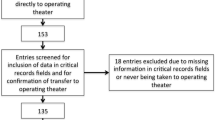Abstract
Introduction
Timely access to acute surgery is a worldwide issue and New Zealand is similarly affected. Auckland City Hospital is one of the largest metropolitan public hospitals in New Zealand where more than 60 % of surgical admissions fit into the acute category. In January 2009, an Acute Surgical Unit (ASU) was set up to improve acute surgical flow. Key performance indicators (KPIs) were identified as valuable tools in evaluating ASU service performance. Our goals were to describe the current acute patient pathway, present the early trend of KPIs for the ASU and determine whether an impact has been made on acute surgical patients.
Methods
A retrospective review of patients admitted with acute general surgical conditions from January 2008 (pre-ASU) to October 2010 was performed. Patient data were identified through hospital electronic records. KPIs assessed included: (1) time to assess referred patients from the emergency department (ED) and from GPs [where patient assessment occurs in the assessment and planning unit (APU)]; (2) preoperative length of stay (LOS[PO]); (3) length of stay of nonadmitted patients (LOS[NA]); (4) case volume “in h” (0730–1730) versus “after h”; and (5) readmission rate. Statistical analysis was performed with one-way ANOVA, regression, and χ2 tests.
Results
Results show a reduction of mean time from referral to assessment from 2.28 to 1.6 h in the ED (p ≤ 0.001). Patients are seen in APU after GP referral sooner as well as the time from referral to assessment reducing from 2 to 1.76 h (p < 0.001). The LOS[PO] has not changed significantly overall (34.58 vs. 34.88 h, p = not significant [NS]). However, there are encouraging signs in high-volume procedures, such as appendicectomy. The mean LOS[PO] for appendicectomy was 7.81 h but is now 6.53 h (p ≤ 0.005). The LOS[NA] has decreased from 15.23 to 9.48 h (p < 0.005). Since the development of the ASU, the number of cases operated on “in hours” is increasing with a corresponding decrease in “after hours” operating.
Conclusions
Our KPIs demonstrate an early positive trend of facilitating acute patient flow. There is minimal difference between pre- and post-ASU LOS[PO].The causes are likely multifactorial, including increased case volume displacing minor cases of lesser urgency, lack of operating staff, and shortage of hospital beds in winter months. This study supports the utility of ASU in facilitating patient flow in a NZ metropolitan public hospital.









Similar content being viewed by others
References
Truskett P (2010) Acute surgical units: the future face of emergency surgery. ANZ J Surg 80:477–478
Cox M, Cook L et al (2010) Acute surgical unit: a new model of care. ANZ J Surg 80:419–424
Otago Clinical Audit (2008–2010) Department of Surgery, Auckland City Hospital, Auckland (unpublished data)
Britt R, Weireter L, Britt LD (2009) Initial implementation of an acute care surgery model: implications for timeliness of care. J Am Coll Surg 209:421–424
Qureshi A, Smith A, Wright F, Brenneman F et al (2011) The impact of an acute care emergency surgical service on timely surgical decision-making and emergency department overcrowding. J Am Coll Surg 213:284–293
Royal Australasian College of Surgeon (2008) Position statement of emergency surgery. http://www.surgeons.org. Accessed 7 July 2008
General Surgeon Association of Australia (2010) 12-Point plan on emergency surgery. http://www.Generalsurgeons.com.au. Accessed 19 Nov 2010
Hsee L, Devaud M, Civil I (2012) The acute surgical unit at Auckland city hospital: a descriptive analysis. ANZ J Surg (in press)
Ministry of Health New Zealand (2011) Targeting emergencies. www.moh.govt.nz. Accessed 15 April 2011
Author information
Authors and Affiliations
Corresponding author
Rights and permissions
About this article
Cite this article
Hsee, L., Devaud, M. & Civil, I. Key Performance Indicators in an Acute Surgical Unit: Have We Made an Impact?. World J Surg 36, 2335–2340 (2012). https://doi.org/10.1007/s00268-012-1670-5
Published:
Issue Date:
DOI: https://doi.org/10.1007/s00268-012-1670-5




